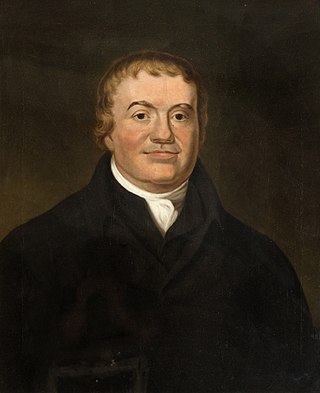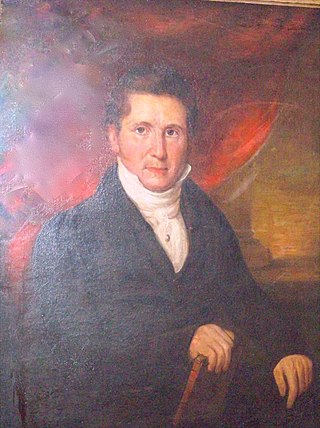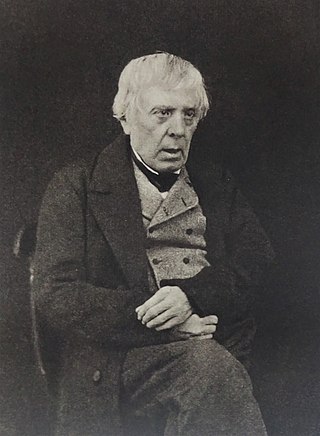Related Research Articles

Ochiltree is a conservation village in East Ayrshire, Scotland, near Auchinleck and Cumnock. It is one of the oldest villages in East Ayrshire, with archaeological remains indicating Stone Age and Bronze Age settlers. A cinerary urn was found in 1955 during excavation for a new housing estate.

A bannock is a variety of flatbread or quick bread cooked from flour, typically round, which is common in Scotland and other areas in Britain and Ireland. They are usually cut into sections before serving.

Edward Priaulx Tennant, 1st Baron Glenconner, styled Sir Edward Tennant, 2nd Baronet from 1906 to 1911, was a Scottish businessman and Liberal politician. In 1911 he was raised to the peerage as Baron Glenconner.

David Dale was a leading Scottish industrialist, merchant and philanthropist during the Scottish Enlightenment period at the end of the 18th century. He was a successful entrepreneur in a number of areas, most notably in the cotton-spinning industry, and was the founder of the cotton mills in New Lanark, where he provided social and educational conditions far in advance of anything available anywhere else in the UK. New Lanark attracted visitors from all over the world. Robert Owen, who married Dale's daughter, Caroline, in 1799, used New Lanark to develop his theories about communitarian living, education and character formation. Scottish historian, Tom Devine, described Dale as 'the greatest cotton magnate of his time in Scotland'.

Wynberg is a southern suburb of the City of Cape Town in Western Cape, South Africa. It is situated between Plumstead and Kenilworth, and is a main transport hub for the Southern Suburbs of Cape Town.
William Macomb was a British colonial merchant and fur trader in the Detroit, Michigan area before and after the American Revolutionary War. He got his start as a young man in the colony of New York. He was a brother of Alexander Macomb, and the two were partners in Detroit.

Charles Tennant was a Scottish chemist and industrialist. He discovered bleaching powder and founded an industrial dynasty.

Sir Charles Clow Tennant, 1st Baronet, was a Scottish businessman, industrialist and Liberal politician.
United Alkali Company Limited was a British chemical company formed in 1890, employing the Leblanc process to produce soda ash for the glass, textile, soap, and paper industries. It became one of the top four British chemical companies merged in 1926 with Brunner Mond, Nobel Explosives and British Dyestuffs Corporation to form Imperial Chemical Industries.

Colin Christopher Paget Tennant, 3rd Baron Glenconner was a British peer, landowner and socialite. He was the son of Christopher Grey Tennant, 2nd Baron Glenconner, and Pamela Winifred Paget. He was also the nephew of Edward Tennant and Stephen Tennant, and the half-brother of the novelist Emma Tennant.

Hercules Ross was a Scottish merchant, who made a fortune in Jamaica, became an intimate friend of Horatio Nelson and figured prominently, if briefly, in the campaign for the abolition of the slave trade. Fiona Scharlau characterises Ross as 'a supreme example of the poor boy who worked hard in a foreign country, creating a life of opportunities that lead to fulfillment of the rags-to-riches dream of the sojourner.' He ended his days at Rossie Castle, a large house which he had built on land acquired by him in Forfarshire.
Tennant is a Scottish surname, and may refer to:

James Oswald was a Scottish merchant and Member of Parliament (MP) for Glasgow.
Benjamin Buck Greene was a British banker, plater, and financier. He inherited a large fortune derived from the Atlantic slave trade and the sugar industry in the Caribbean, later becoming one of London's leading merchants and shipowners. He served as a director of the Bank of England for fifty years from 1850, also serving as deputy governor (1871-3) and governor (1873–5).

William Macadam was an industrialist, a burgess and bailie of Glasgow. He owned a weaving mill and calico printing works in Kilmarnock near Glasgow.
Several ships have borne the name Caledonia for Caledonia:
C. Tennant, Sons & Company was a British merchant bank that was prominent in metals and minerals markets, and also played a key role in development of the Gulf States in their early years of independence. The firm's antecedents go back to the early 19th century. In the early 1960s it had its main offices at Harp Lane in the City of London as well as offices in New York, San Francisco, São Paulo, Lima, La Paz and Bermuda.
Thomas Hughan was a Scottish slave trader, merchant and politician affiliated with the West India Dock Company.

Robert Burns Junior or Robert Burns ll (1786–1857) was the first son and one of the first pair of twins born to the poet Robert Burns and his wife Jean Armour. He was born on the 3 September 1786 and baptised on 5 September. John Tennant of Glenconner was a witness at the baptism. His twin sister was Jean Burns, who died of unknown causes in infancy on 20 October 1787. His father, who often called him 'Bobbie', died when Robert Junior was only nine years old, at which point he was the eldest of a family of five legitimate male offspring.
References
- ↑ Dugdale, James: Tennant's Stalk, London, Macmillan, 1973, page xv.
- ↑ Stewart, George: Curiosities of Glasgow Citizenship, Glasgow, James Maclehose, Publisher to the University, 1881.
- ↑ Tennant, Rev William (1808). Indian Recreations: Consisting of Thoughts on the Effects of the British Government on the State of India, Accompanied with Hints Concerning the Means of Improving the Condition of the Natives of that Country. Printed at the University Press, and sold by Longman, Hurst, Rees,& Orme.
- ↑ Cozens, Ken (25 May 2006). "Captain Donald Trail - Hero or villain?". www.merchantnetworks.com.au.
- ↑ Worden, Nigel: Cape Town: The Making of a City, Uitgeverij Verloren, Cape Town, 1998, page 99.
- ↑ Theal, George McCall: History of South Africa, 1795-1834, Swan Sonnenschein, South Africa, 1898, page 135.
- ↑ "Wynberg Military Base". Archived from the original on 18 March 2008. Retrieved 15 February 2008.
- ↑ Society of Chemical Industry: Journal of the Society of Chemical Industry, London , 1950, page 411.